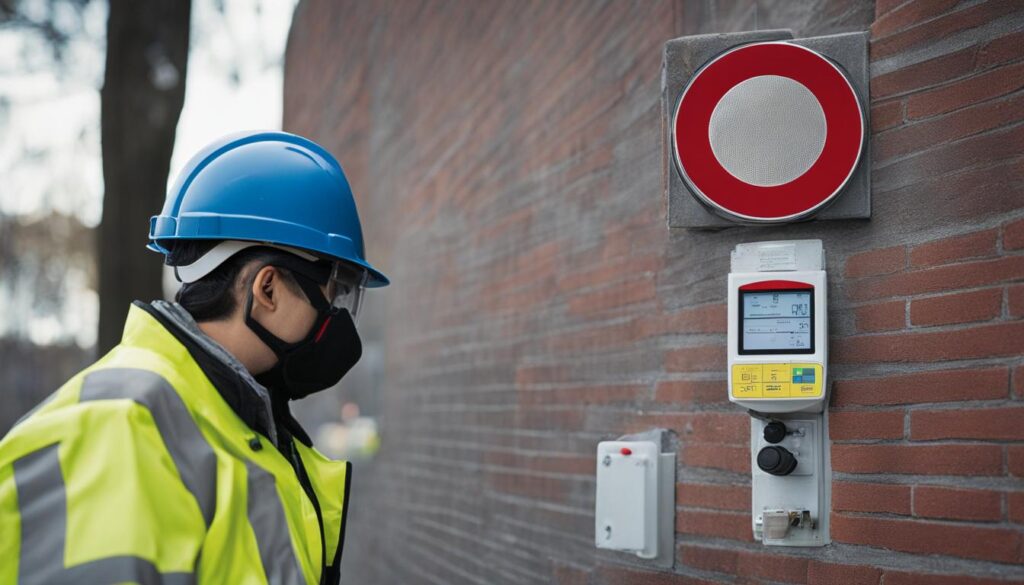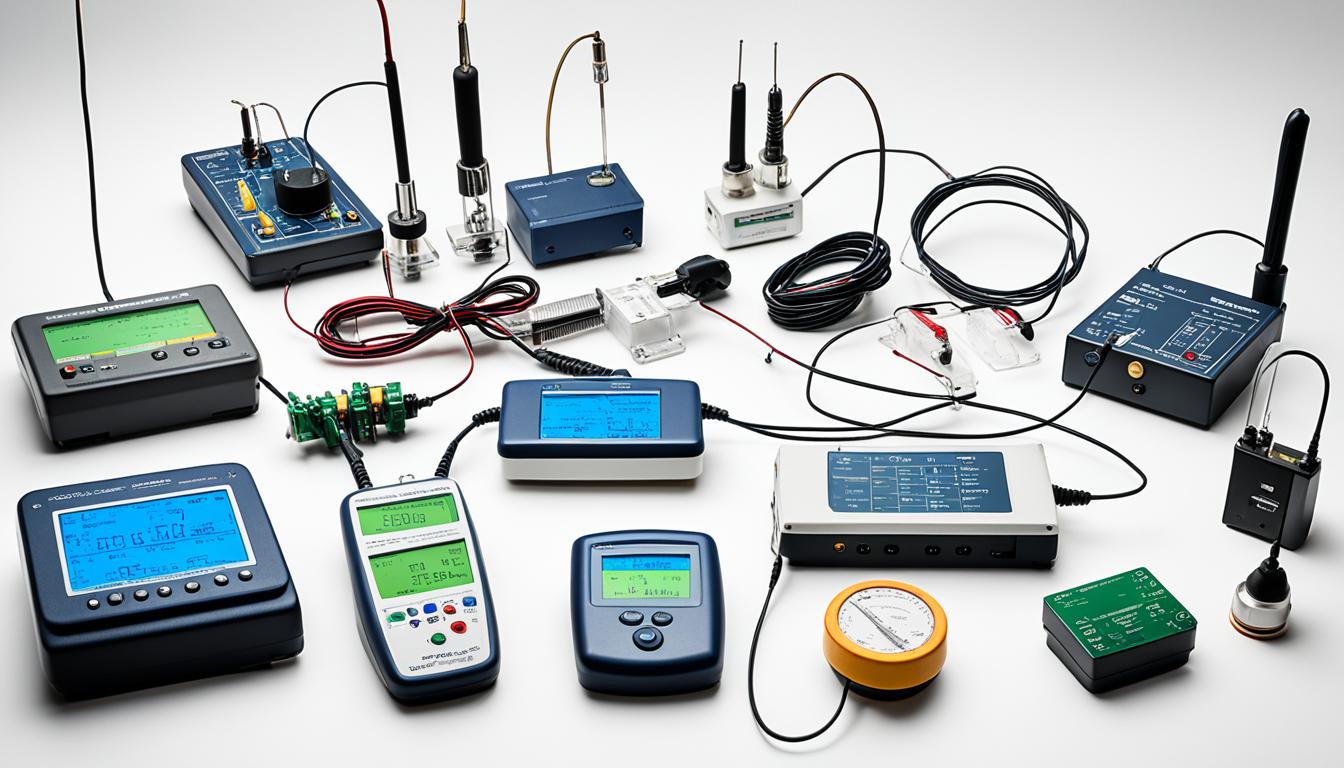Disclosure: This Post Contains Affiliate Links; We earn a commission on purchases.
Assessing EMF levels in public spaces is crucial for ensuring the health and safety of individuals. Studies have shown that exposure to electromagnetic fields (EMFs) from wireless networks can have potential health impacts. Research conducted in urban areas has focused on measuring RF-EMF exposure levels in public spaces such as schools and universities. These studies have used various methods, including personal exposure meters and microenvironmental measurements, to determine the levels of RF-EMFs in different environments. The goal of these assessments is to understand the spatial and temporal variability of RF-EMF exposure and to establish guidelines for safe levels of exposure in public spaces.
Key Takeaways:
- Assessing EMF levels in public spaces is important for identifying and addressing potential health and safety concerns.
- Various methods, such as personal exposure meters and microenvironmental measurements, can be used to assess EMF levels.
- RF-EMF exposure levels in public spaces vary spatially and temporally, with specific locations and activities exhibiting higher levels.
- Guidelines and regulations have been established to ensure EMF safety in public spaces, setting exposure limits based on scientific research.
- As technology advances, future considerations for assessing EMF levels must take into account the impact of 5G technology and advancements in measurement techniques.
Importance of Assessing EMF Levels in Public Spaces
Assessing EMF levels in public spaces is of utmost importance due to the potential health and safety concerns associated with RF-EMF exposure. With the widespread use of wireless networks in urban environments, it is crucial to understand the impact of these technologies on public health. Studies have shown that high levels of RF-EMFs can have detrimental effects, including an increased risk of cancer, neurological disorders, and fertility problems.
By assessing EMF levels in public spaces, policymakers and health authorities can gain valuable insights into the extent of exposure and implement appropriate measures to minimize potential risks. Through continuous monitoring of RF-EMF levels, we can ensure the safety and well-being of individuals in these environments.
Moreover, as wireless networks continue to expand and evolve, understanding the impact of EMF exposure becomes even more critical. The advent of 5G technology brings new challenges, as it utilizes adaptive antennas and introduces higher spatio-temporal variations in RF-EMF levels. By assessing and monitoring EMF levels in public spaces, we can proactively address these challenges and develop strategies to mitigate any potential risks.
The Impact of Wireless Networks on Urban Environments
Wireless networks have become an integral part of our urban environments, providing connectivity and convenience. However, it is essential to consider the impact of these networks on public health and safety. The increasing number of wireless devices and infrastructure such as cell towers and Wi-Fi access points contribute to higher EMF exposure levels.
Urban environment monitoring plays a crucial role in assessing EMF levels in public spaces. By conducting comprehensive measurements and analysis, we can identify hotspots of high exposure and implement measures to reduce and manage RF-EMF levels effectively. This ensures the well-being of individuals who frequent these areas, such as schools, parks, and office buildings.
EMF exposure can have serious health implications, and it is our responsibility to assess and mitigate potential risks. By monitoring EMF levels in public spaces, we can take proactive steps towards creating safer and healthier urban environments.
| Health and Safety Concerns | Wireless Network Impact |
|---|---|
|
|
By understanding the importance of assessing EMF levels in public spaces, we can prioritize the health and safety of individuals. Through effective monitoring and mitigation strategies, we can create urban environments that are safe and conducive to the well-being of all residents and visitors.
Methods for Assessing EMF Levels in Public Spaces
Various methods can be used to assess EMF levels in public spaces. These methods play a crucial role in understanding the potential health risks associated with RF-EMF exposure. By employing accurate measurement techniques, researchers can gather data to inform effective guidelines and regulations for public safety.
Personal Exposure Meters (PEMs)
An essential tool in assessing RF-EMF levels is the use of personal exposure meters (PEMs). These portable devices are worn by individuals to measure their personal exposure throughout the day. PEMs provide valuable data on the levels of RF-EMFs that people are exposed to in different environments, including public spaces such as schools, offices, and outdoor areas.
Microenvironmental Measurements
Another approach to assessing EMF levels in public spaces is through microenvironmental measurements. Trained researchers conduct these measurements in predefined microenvironments, allowing for more targeted analysis. By focusing on specific locations within public spaces, such as classrooms or offices, researchers can assess how RF-EMF exposure levels vary within different settings.
Population Surveys
Population surveys involve selecting a sample of individuals and providing them with measurement devices to carry with them for a certain period. These surveys capture the RF-EMF exposure levels experienced by individuals in various public spaces. By collecting data from a diverse group of participants, researchers can gain insights into the general population’s exposure levels and identify potential high-exposure areas that require further investigation.
Simulation Studies
In addition to field measurements, simulation studies are an important method for assessing EMF levels in public spaces. These studies use computer models to simulate RF-EMF exposure in different environments. By inputting data on wireless network configurations, antenna locations, and user behaviors, researchers can predict RF-EMF levels and their spatial distribution. Simulation studies complement field measurements and provide valuable insights into the overall EMF exposure landscape in public spaces.
By employing a combination of these assessment methods—personal exposure meters, microenvironmental measurements, population surveys, and simulation studies—researchers can gather comprehensive data on EMF levels in public spaces. These data provide a foundation for understanding RF-EMF exposure patterns, identifying high-exposure areas, and developing effective strategies to mitigate potential health risks.
Findings from EMF Assessment Studies in Public Spaces
Several studies have been conducted to assess RF-EMF exposure levels in public spaces, such as schools, universities, and urban environments. These studies provide valuable insights into the spatial and temporal variability of RF-EMF exposure, highlighting specific locations and high-exposure areas.
RF-EMF Exposure Levels
The findings from EMF assessment studies have revealed that RF-EMF exposure levels can vary significantly in different public spaces. Certain areas exhibit higher levels of RF-EMF exposure compared to others, depending on factors such as proximity to wireless infrastructure and the presence of wireless devices.
Spatial and Temporal Variability
One of the key findings is the spatial and temporal variability of RF-EMF exposure. This means that exposure levels can differ based on the location within a public space and can also vary at different times of the day or during specific activities. For example, areas near cell towers or Wi-Fi access points tend to have higher RF-EMF exposure levels.
Specific Locations
The studies have identified specific locations within public spaces where RF-EMF exposure levels are particularly high. These locations may include classrooms, offices, or other areas that are in close proximity to wireless devices or have a high concentration of wireless activity.
High-Exposure Areas
High-exposure areas in public spaces are areas where RF-EMF exposure levels consistently exceed the average exposure levels. These areas may require special attention in terms of EMF safety measures and mitigation strategies to minimize health risks for individuals occupying those spaces.
Assessing the findings from EMF assessment studies in public spaces provides valuable insights into the distribution of RF-EMF exposure levels and helps identify specific areas that may require targeted interventions to ensure the safety of individuals in those spaces.
| Study | Location | Key Findings |
|---|---|---|
| Study 1 | Schools | Higher RF-EMF exposure levels observed in classrooms near Wi-Fi routers. |
| Study 2 | Urban areas | Variations in RF-EMF exposure levels depending on proximity to cell towers. |
| Study 3 | Universities | Higher RF-EMF exposure levels in lecture halls with a high density of wireless devices. |
These findings highlight the importance of continuous monitoring and assessment of EMF exposure levels in public spaces to ensure the safety and well-being of individuals. By understanding the specific locations and high-exposure areas, appropriate measures can be implemented to minimize RF-EMF exposure and protect public health.
Guidelines and Regulations for EMF Safety in Public Spaces
Ensuring the safety of individuals in public spaces requires the establishment of guidelines and regulations for electromagnetic field (EMF) safety. These guidelines are based on scientific research and set exposure limits for radiofrequency EMFs to mitigate potential health effects. Regulatory frameworks vary by country or region, but their primary goal is to maintain exposure levels within acceptable limits, safeguarding public health and well-being.
By implementing EMF safety guidelines, governments and regulatory bodies prioritize public health and protection. These guidelines are essential for wireless network regulations and play a crucial role in setting exposure limits to mitigate potential risks. Based on extensive research and scientific consensus, these guidelines provide a framework for authorities to ensure the safe use of wireless technologies in public spaces.
Public health protection is a primary concern when it comes to EMF safety in public spaces. By implementing exposure limits and regulatory frameworks, authorities aim to minimize potential health risks associated with RF-EMF exposure. These measures ensure that individuals can use and access wireless networks without compromising their well-being.
Regulatory Frameworks for EMF Safety
Regulatory frameworks for EMF safety are developed by governmental and non-governmental organizations to establish rules and standards to protect public health. These frameworks outline exposure limits, monitoring requirements, and enforcement mechanisms to ensure compliance. However, specific regulations may differ across different countries or regions.
The International Commission on Non-Ionizing Radiation Protection (ICNIRP) is a globally recognized organization that provides guidance and recommendations for EMF exposure limits. Their guidelines aim to protect individuals from potential health risks associated with RF-EMF exposure in public spaces.
Additionally, regulatory bodies such as the Federal Communications Commission (FCC) in the United States and the European Union’s Council Recommendation on Limiting Exposure to Electromagnetic Fields play crucial roles in establishing and enforcing EMF safety regulations.
Exposure Limits and Safety Measures
Exposure limits specified in EMF safety guidelines serve as reference values for controlling RF-EMF exposure in public spaces. These limits are determined based on comprehensive scientific studies and aim to keep exposure levels below the levels associated with potential health effects.
Wireless network operators and infrastructure providers are required to comply with these exposure limits by implementing safety measures. These measures may include regular monitoring and assessment of RF-EMF levels, adopting appropriate technologies and practices to minimize exposure, and providing public education and awareness campaigns about EMF safety.
| Regulatory Body | Exposure Limits | Safety Measures |
|---|---|---|
| ICNIRP | Establishes guidelines for RF-EMF exposure limits in public environments. | Ensures compliance through monitoring, evaluation, and awareness campaigns. |
| FCC | Sets exposure limits for RF-EMF emissions from wireless devices and infrastructure. | Enforces compliance and encourages the development of safe technologies. |
| European Union | Provides recommendations for limiting EMF exposure in public spaces. | Imposes regulations and promotes research on EMF safety. |

Future Considerations for Assessing EMF Levels in Public Spaces
As technology continues to advance, it is crucial to consider the future implications of assessing electromagnetic field (EMF) levels in public spaces. With the deployment of 5G networks and the utilization of adaptive antennas and massive multiple-input multiple-output (MaMIMO) technology, the impact on EMF levels is expected to be significant.
5G technology brings about increased spatio-temporal variations in RF-EMF levels, posing challenges for accurate measurements. The dynamic nature of adaptive antennas, which adjust their directionality and beamforming, can result in fluctuating EMF exposure levels in different locations and at different times. This poses a challenge when assessing overall exposure levels and ensuring the safety of individuals in public spaces.
Another important consideration is auto-induced exposure, which refers to the RF-EMF emitted by individuals’ own devices, such as smartphones and wearables. As these devices become increasingly prevalent, measuring the specific RF-EMF exposure from user devices becomes essential. However, this introduces a higher degree of measurement uncertainty, as the exposure levels can vary depending on device usage, proximity, and wireless network load.
Measurement Uncertainty and Future Research
The measurement uncertainty surrounding RF-EMF exposure assessment in public spaces deserves further attention. Advances in measurement techniques are necessary to accurately measure the complex EMF environment in the presence of 5G networks and adaptive antennas. Researchers and technology developers must work collaboratively to enhance measurement capabilities, improve spatial and temporal resolution, and reduce uncertainties.
“Accurate assessment of EMF levels in public spaces is paramount for understanding the potential health effects and ensuring the safety of individuals. As 5G technology continues to evolve and play a more significant role in our daily lives, we must address the challenges it presents in accurately assessing EMF exposure levels in public spaces.”
A comprehensive understanding of the impact of 5G technology on RF-EMF levels in public spaces will enable policymakers, health authorities, and industry experts to implement appropriate guidelines and regulations. Striking a balance between technological advancements and protecting public health is crucial as we navigate the future of wireless networks in public spaces.

As we move forward, it is essential to prioritize ongoing research and collaboration to ensure that future assessment methods account for the evolving landscape of EMF exposure in public spaces. By doing so, we can continue to protect the health and well-being of individuals while harnessing the benefits of wireless technologies.
Conclusion
In conclusion, the assessment of EMF levels in public spaces is crucial for understanding and addressing the potential health and safety implications associated with RF-EMF exposure. Studies have shown that RF-EMF levels vary in different environments, both spatially and temporally, emphasizing the need for continuous monitoring and assessment.
Current guidelines and regulations provide a framework for ensuring EMF safety in public spaces, but it is essential to consider the impact of advancing technologies like 5G and the evolution of measurement techniques. Ongoing monitoring and assessment of EMF levels are necessary to protect public health and ensure the safe use of wireless networks in public spaces.
By implementing appropriate measures based on EMF assessment summaries, authorities can prioritize public space monitoring and address health and safety considerations effectively. This proactive approach will contribute to creating a safer environment for individuals exposed to RF-EMFs in public spaces, promoting overall well-being in the community.
Source Links
- https://www.ncbi.nlm.nih.gov/pmc/articles/PMC10560042/
- https://www.ncbi.nlm.nih.gov/pmc/articles/PMC6466609/
- https://ehjournal.biomedcentral.com/articles/10.1186/s12940-021-00719-w

Subscribe to Our Newsletter










